FIAT 500L 2018 Owner handbook (in English)
Manufacturer: FIAT, Model Year: 2018, Model line: 500L, Model: FIAT 500L 2018Pages: 268, PDF Size: 4.87 MB
Page 171 of 268
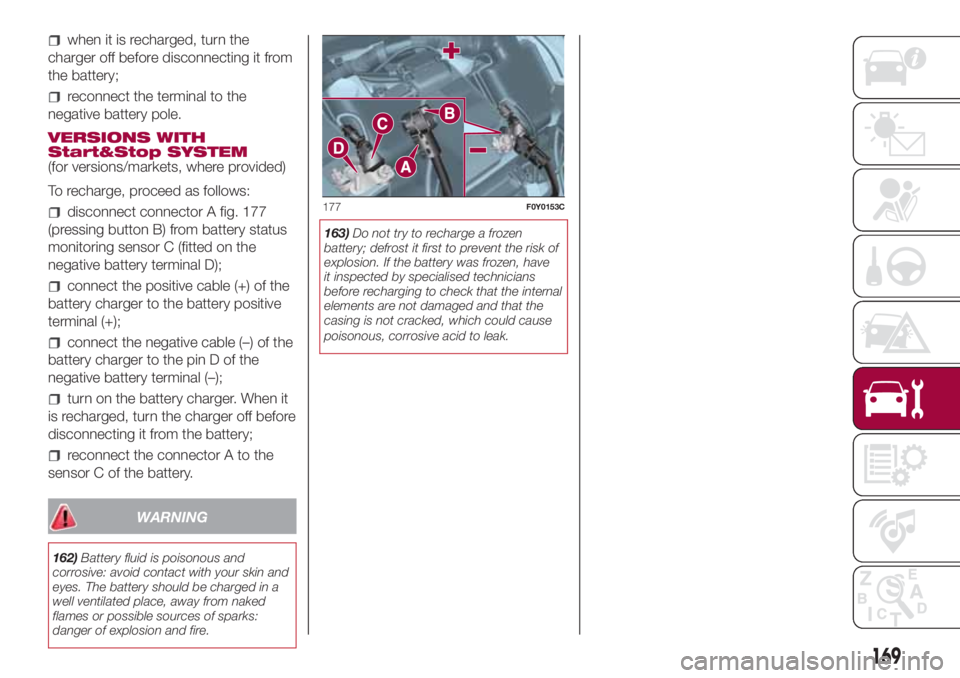
when it is recharged, turn the
charger off before disconnecting it from
the battery;
reconnect the terminal to the
negative battery pole.
VERSIONS WITH
Start&Stop SYSTEM
(for versions/markets, where provided)
To recharge, proceed as follows:
disconnect connector A fig. 177
(pressing button B) from battery status
monitoring sensor C (fitted on the
negative battery terminal D);
connect the positive cable (+) of the
battery charger to the battery positive
terminal (+);
connect the negative cable (–) of the
battery charger to the pin D of the
negative battery terminal (–);
turn on the battery charger. When it
is recharged, turn the charger off before
disconnecting it from the battery;
reconnect the connector A to the
sensor C of the battery.
WARNING
162)Battery fluid is poisonous and
corrosive: avoid contact with your skin and
eyes. The battery should be charged in a
well ventilated place, away from naked
flames or possible sources of sparks:
danger of explosion and fire.163)Do not try to recharge a frozen
battery; defrost it first to prevent the risk of
explosion. If the battery was frozen, have
it inspected by specialised technicians
before recharging to check that the internal
elements are not damaged and that the
casing is not cracked, which could cause
poisonous, corrosive acid to leak.
177F0Y0153C
169
Page 172 of 268
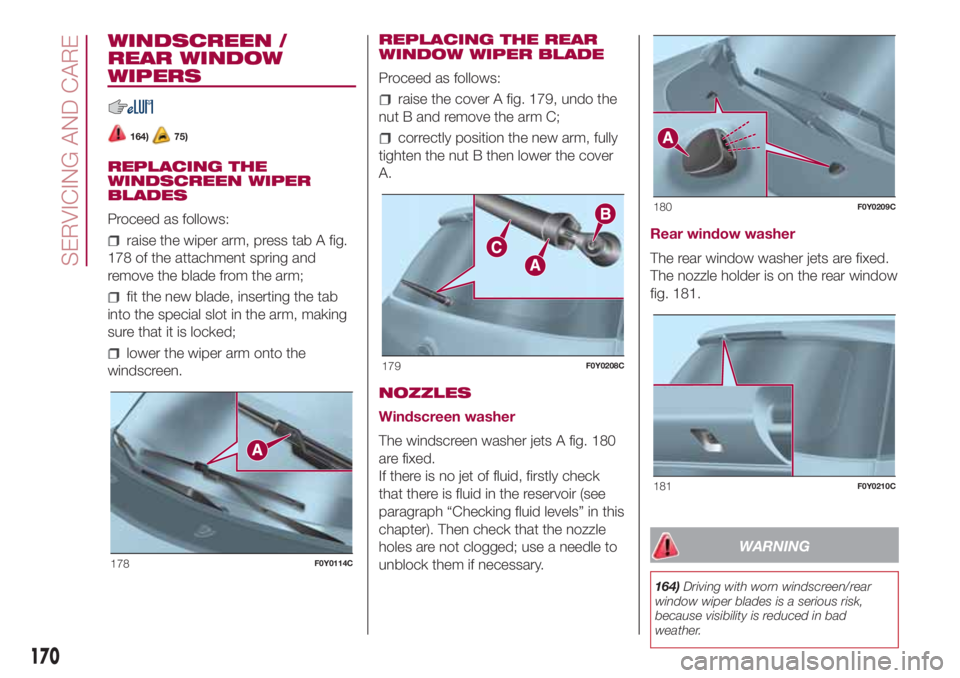
WINDSCREEN /
REAR WINDOW
WIPERS
164)75)
REPLACING THE
WINDSCREEN WIPER
BLADES
Proceed as follows:
raise the wiper arm, press tab A fig.
178 of the attachment spring and
remove the blade from the arm;
fit the new blade, inserting the tab
into the special slot in the arm, making
sure that it is locked;
lower the wiper arm onto the
windscreen.REPLACING THE REAR
WINDOW WIPER BLADE
Proceed as follows:
raise the cover A fig. 179, undo the
nut B and remove the arm C;
correctly position the new arm, fully
tighten the nut B then lower the cover
A.
NOZZLES
Windscreen washer
The windscreen washer jets A fig. 180
are fixed.
If there is no jet of fluid, firstly check
that there is fluid in the reservoir (see
paragraph “Checking fluid levels” in this
chapter). Then check that the nozzle
holes are not clogged; use a needle to
unblock them if necessary.Rear window washer
The rear window washer jets are fixed.
The nozzle holder is on the rear window
fig. 181.
WARNING
164)Driving with worn windscreen/rear
window wiper blades is a serious risk,
because visibility is reduced in bad
weather.
178F0Y0114C
179F0Y0208C
180F0Y0209C
181F0Y0210C
170
SERVICING AND CARE
Page 173 of 268
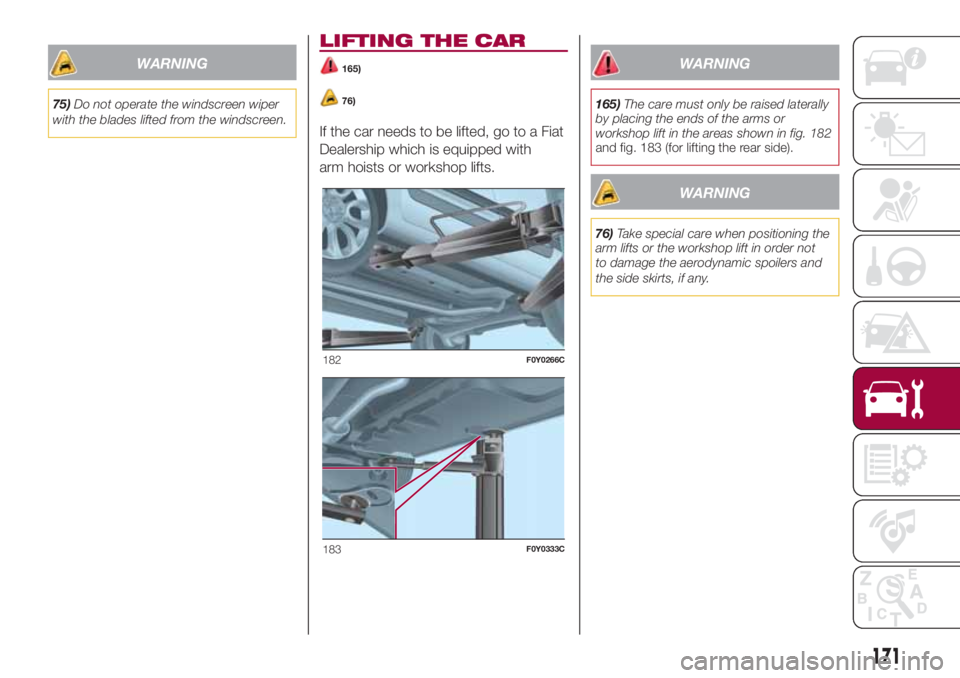
WARNING
75)Do not operate the windscreen wiper
with the blades lifted from the windscreen.
LIFTING THE CAR
165)
76)
If the car needs to be lifted, go to a Fiat
Dealership which is equipped with
arm hoists or workshop lifts.
WARNING
165)The care must only be raised laterally
by placing the ends of the arms or
workshop lift in the areas shown in fig. 182
and fig. 183 (for lifting the rear side).
WARNING
76)Take special care when positioning the
arm lifts or the workshop lift in order not
to damage the aerodynamic spoilers and
the side skirts, if any.
182F0Y0266C
183F0Y0333C
171
Page 174 of 268
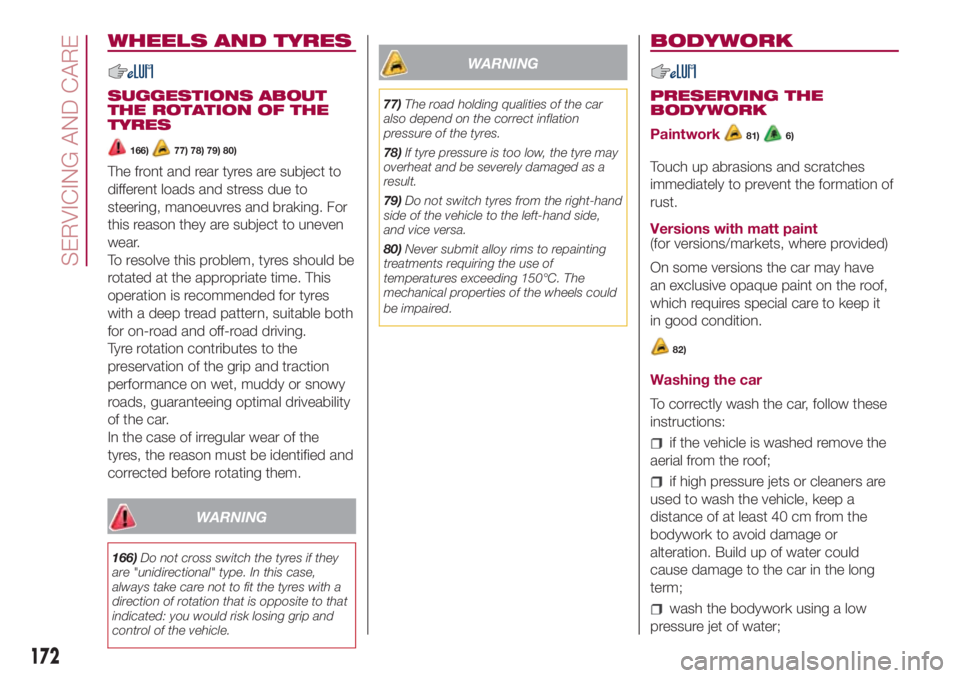
WHEELS AND TYRES
SUGGESTIONS ABOUT
THE ROTATION OF THE
TYRES
166)77) 78) 79) 80)
The front and rear tyres are subject to
different loads and stress due to
steering, manoeuvres and braking. For
this reason they are subject to uneven
wear.
To resolve this problem, tyres should be
rotated at the appropriate time. This
operation is recommended for tyres
with a deep tread pattern, suitable both
for on-road and off-road driving.
Tyre rotation contributes to the
preservation of the grip and traction
performance on wet, muddy or snowy
roads, guaranteeing optimal driveability
of the car.
In the case of irregular wear of the
tyres, the reason must be identified and
corrected before rotating them.
WARNING
166)Do not cross switch the tyres if they
are "unidirectional" type. In this case,
always take care not to fit the tyres with a
direction of rotation that is opposite to that
indicated: you would risk losing grip and
control of the vehicle.
WARNING
77)The road holding qualities of the car
also depend on the correct inflation
pressure of the tyres.
78)If tyre pressure is too low, the tyre may
overheat and be severely damaged as a
result.
79)Do not switch tyres from the righthand
side of the vehicle to the lefthand side,
and vice versa.
80)Never submit alloy rims to repainting
treatments requiring the use of
temperatures exceeding 150°C. The
mechanical properties of the wheels could
be impaired.
BODYWORK
PRESERVING THE
BODYWORK
Paintwork
81)6)
Touch up abrasions and scratches
immediately to prevent the formation of
rust.
Versions with matt paint
(for versions/markets, where provided)
On some versions the car may have
an exclusive opaque paint on the roof,
which requires special care to keep it
in good condition.
82)
Washing the car
To correctly wash the car, follow these
instructions:
if the vehicle is washed remove the
aerial from the roof;
if high pressure jets or cleaners are
used to wash the vehicle, keep a
distance of at least 40 cm from the
bodywork to avoid damage or
alteration. Build up of water could
cause damage to the car in the long
term;
wash the bodywork using a low
pressure jet of water;
172
SERVICING AND CARE
Page 175 of 268
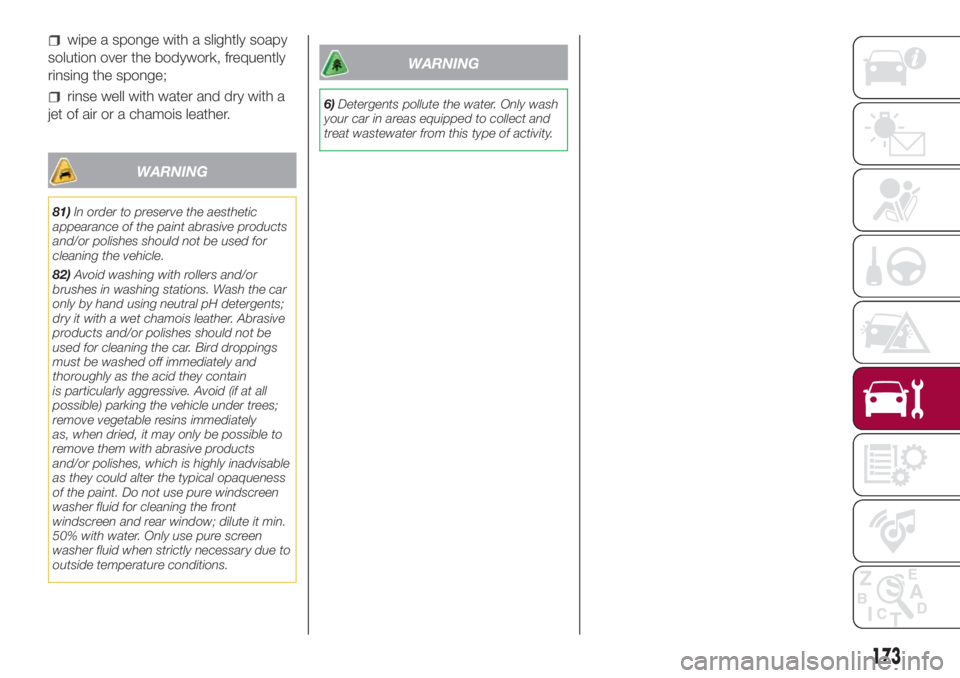
wipe a sponge with a slightly soapy
solution over the bodywork, frequently
rinsing the sponge;
rinse well with water and dry with a
jet of air or a chamois leather.
WARNING
81)In order to preserve the aesthetic
appearance of the paint abrasive products
and/or polishes should not be used for
cleaning the vehicle.
82)Avoid washing with rollers and/or
brushes in washing stations. Wash the car
only by hand using neutral pH detergents;
dry it with a wet chamois leather. Abrasive
products and/or polishes should not be
used for cleaning the car. Bird droppings
must be washed off immediately and
thoroughly as the acid they contain
is particularly aggressive. Avoid (if at all
possible) parking the vehicle under trees;
remove vegetable resins immediately
as, when dried, it may only be possible to
remove them with abrasive products
and/or polishes, which is highly inadvisable
as they could alter the typical opaqueness
of the paint. Do not use pure windscreen
washer fluid for cleaning the front
windscreen and rear window; dilute it min.
50% with water. Only use pure screen
washer fluid when strictly necessary due to
outside temperature conditions.
WARNING
6)Detergents pollute the water. Only wash
your car in areas equipped to collect and
treat wastewater from this type of activity.
173
Page 176 of 268
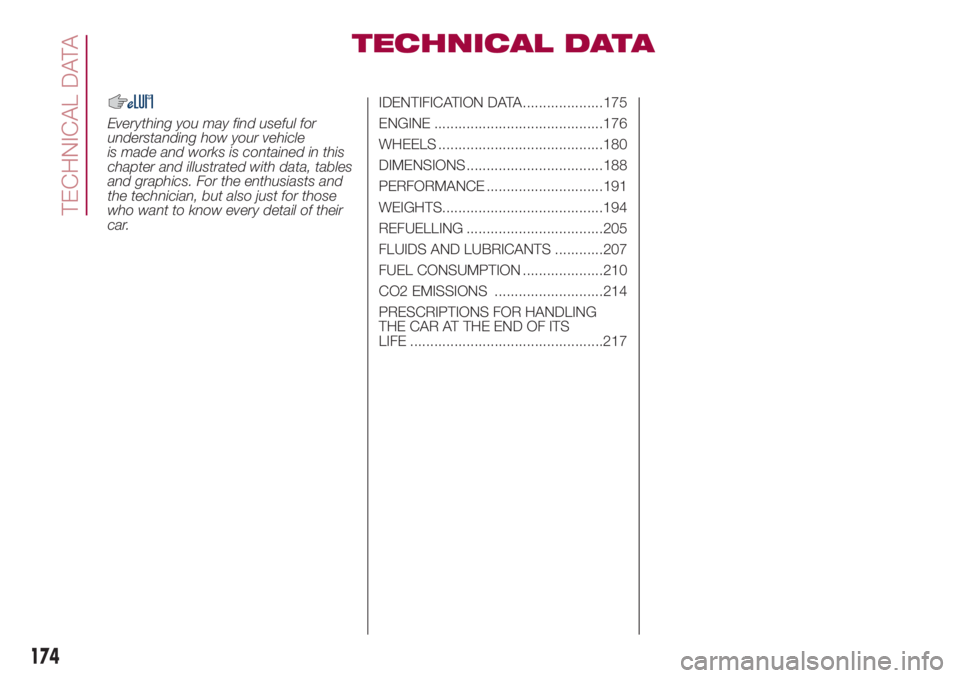
TECHNICAL DATA
Everything you may find useful for
understanding how your vehicle
is made and works is contained in this
chapter and illustrated with data, tables
and graphics. For the enthusiasts and
the technician, but also just for those
who want to know every detail of their
car.IDENTIFICATION DATA....................175
ENGINE ..........................................176
WHEELS .........................................180
DIMENSIONS ..................................188
PERFORMANCE .............................191
WEIGHTS........................................194
REFUELLING ..................................205
FLUIDS AND LUBRICANTS ............207
FUEL CONSUMPTION ....................210
CO2 EMISSIONS ...........................214
PRESCRIPTIONS FOR HANDLING
THE CAR AT THE END OF ITS
LIFE ................................................217
174
TECHNICAL DATA
Page 177 of 268
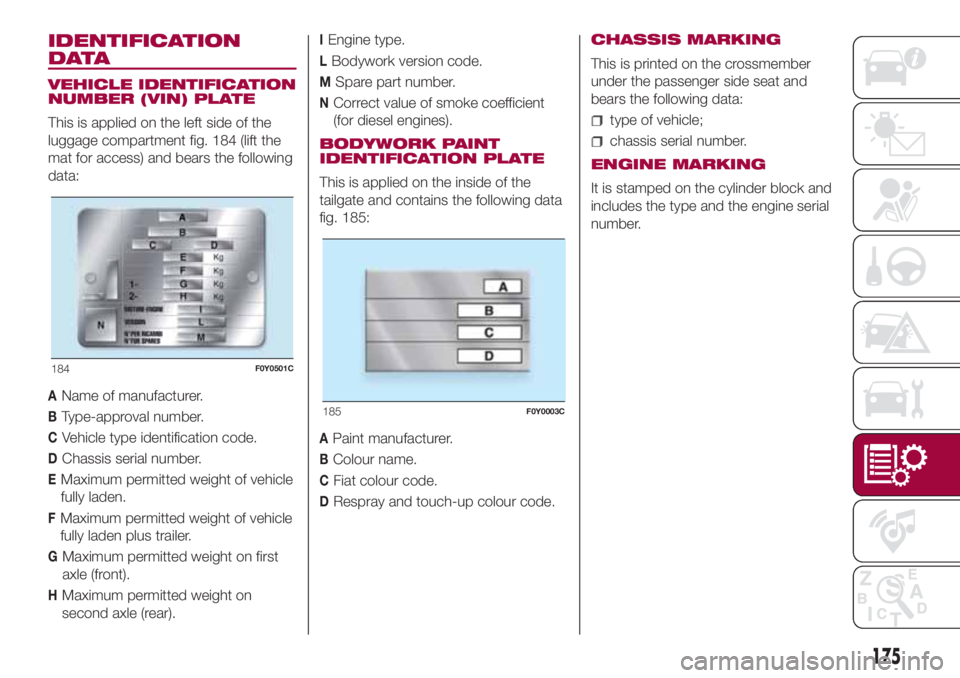
IDENTIFICATION
DATA
VEHICLE IDENTIFICATION
NUMBER (VIN) PLATE
This is applied on the left side of the
luggage compartment fig. 184 (lift the
mat for access) and bears the following
data:
AName of manufacturer.
BType-approval number.
CVehicle type identification code.
DChassis serial number.
EMaximum permitted weight of vehicle
fully laden.
FMaximum permitted weight of vehicle
fully laden plus trailer.
GMaximum permitted weight on first
axle (front).
HMaximum permitted weight on
second axle (rear).
IEngine type.
LBodywork version code.
MSpare part number.
NCorrect value of smoke coefficient
(for diesel engines).
BODYWORK PAINT
IDENTIFICATION PLATE
This is applied on the inside of the
tailgate and contains the following data
fig. 185:
APaint manufacturer.
BColour name.
CFiat colour code.
DRespray and touch-up colour code.CHASSIS MARKING
This is printed on the crossmember
under the passenger side seat and
bears the following data:
type of vehicle;
chassis serial number.
ENGINE MARKING
It is stamped on the cylinder block and
includes the type and the engine serial
number.
184F0Y0501C
185F0Y0003C
175
Page 178 of 268
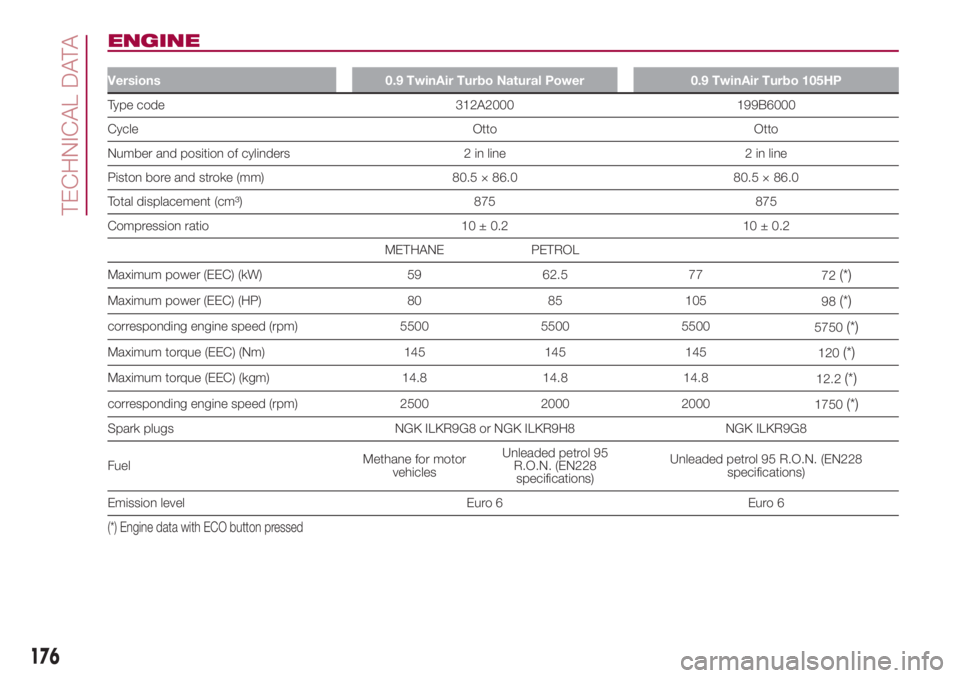
ENGINE
Versions 0.9 TwinAir Turbo Natural Power 0.9 TwinAir Turbo 105HP
Type code 312A2000 199B6000
Cycle Otto Otto
Number and position of cylinders 2 in line 2 in line
Piston bore and stroke (mm) 80.5 × 86.0 80.5 × 86.0
Total displacement (cm³) 875 875
Compression ratio 10 ± 0.2 10 ± 0.2
METHANE PETROL
Maximum power (EEC) (kW) 59 62.5 77
72
(*)
Maximum power (EEC) (HP) 80 85 105
98(*)
corresponding engine speed (rpm) 5500 5500 5500
5750(*)
Maximum torque (EEC) (Nm) 145 145 145
120(*)
Maximum torque (EEC) (kgm) 14.8 14.8 14.8
12.2(*)
corresponding engine speed (rpm) 2500 2000 2000
1750(*)
Spark plugs NGK ILKR9G8 or NGK ILKR9H8 NGK ILKR9G8
FuelMethane for motor
vehiclesUnleaded petrol 95
R.O.N. (EN228
specifications)Unleaded petrol 95 R.O.N. (EN228
specifications)
Emission level Euro 6 Euro 6
(*) Engine data with ECO button pressed
176
TECHNICAL DATA
Page 179 of 268
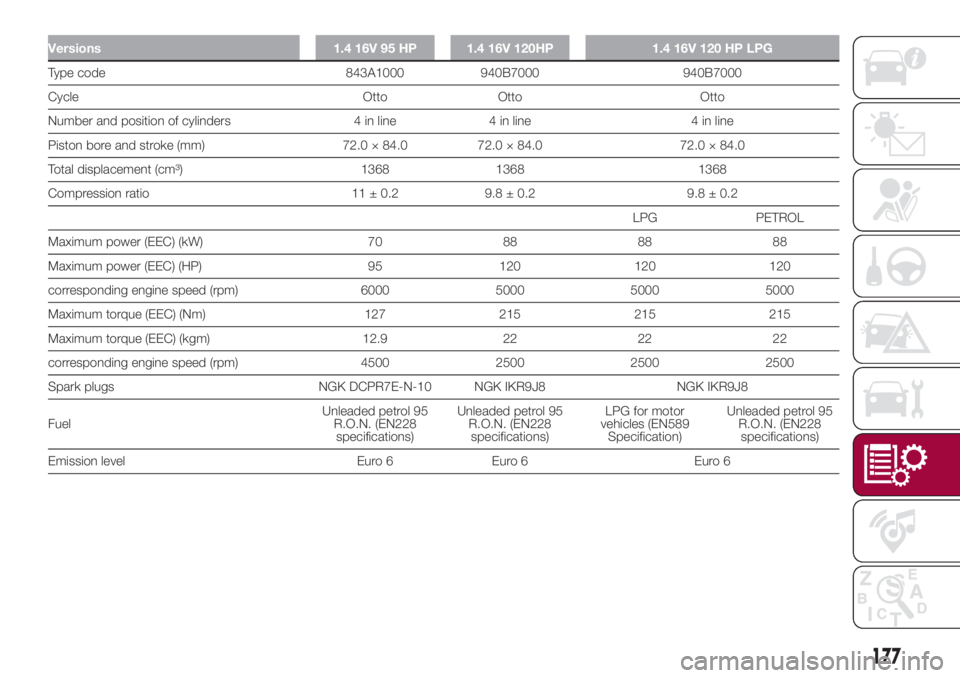
Versions 1.4 16V 95 HP 1.4 16V 120HP 1.4 16V 120 HP LPG
Type code 843A1000 940B7000 940B7000
Cycle Otto Otto Otto
Number and position of cylinders 4 in line 4 in line 4 in line
Piston bore and stroke (mm) 72.0 × 84.0 72.0 × 84.0 72.0 × 84.0
Total displacement (cm³) 1368 1368 1368
Compression ratio 11 ± 0.2 9.8 ± 0.2 9.8 ± 0.2
LPG PETROL
Maximum power (EEC) (kW) 70 88 88 88
Maximum power (EEC) (HP) 95 120 120 120
corresponding engine speed (rpm) 6000 5000 5000 5000
Maximum torque (EEC) (Nm) 127 215 215 215
Maximum torque (EEC) (kgm) 12.9 22 22 22
corresponding engine speed (rpm) 4500 2500 2500 2500
Spark plugs NGK DCPR7E-N-10 NGK IKR9J8 NGK IKR9J8
FuelUnleaded petrol 95
R.O.N. (EN228
specifications)Unleaded petrol 95
R.O.N. (EN228
specifications)LPG for motor
vehicles (EN589
Specification)Unleaded petrol 95
R.O.N. (EN228
specifications)
Emission level Euro 6 Euro 6 Euro 6
177
Page 180 of 268
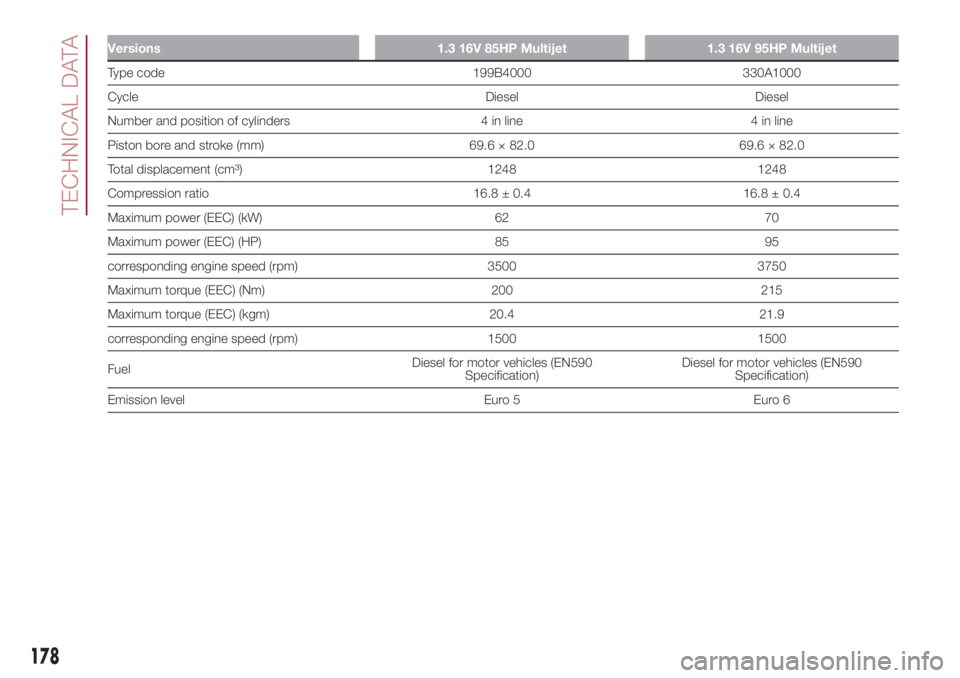
Versions 1.3 16V 85HP Multijet 1.3 16V 95HP Multijet
Type code 199B4000 330A1000
Cycle Diesel Diesel
Number and position of cylinders 4 in line 4 in line
Piston bore and stroke (mm) 69.6 × 82.0 69.6 × 82.0
Total displacement (cm³) 1248 1248
Compression ratio 16.8 ± 0.4 16.8 ± 0.4
Maximum power (EEC) (kW) 62 70
Maximum power (EEC) (HP) 85 95
corresponding engine speed (rpm) 3500 3750
Maximum torque (EEC) (Nm) 200 215
Maximum torque (EEC) (kgm) 20.4 21.9
corresponding engine speed (rpm) 1500 1500
FuelDiesel for motor vehicles (EN590
Specification)Diesel for motor vehicles (EN590
Specification)
Emission level Euro 5 Euro 6
178
TECHNICAL DATA